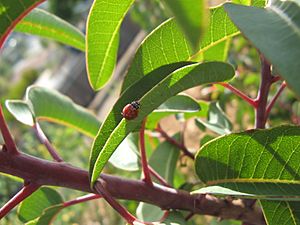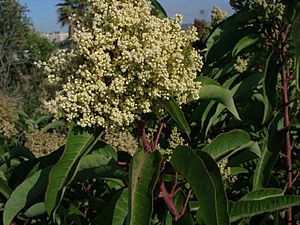Laurel sumac facts for kids
Quick facts for kids Laurel sumac |
|
|---|---|
 |
|
| Malosma laurina, the Laurel sumac |
|
| Scientific classification | |
| Genus: |
Malosma
|
| Species: |
laurina
|

The laurel sumac (scientific name: Malosma laurina) is a special type of plant. It's the only species in its group, called Malosma. People also call it "lentisco" in Spanish.
You can find the laurel sumac growing along the coasts of southern California and the Baja California peninsula in Mexico. It loves the warm weather near the Pacific Ocean.
Contents
What Does Laurel Sumac Look Like?
The laurel sumac is a big, round evergreen shrub or a small tree. It can grow to be about 3 to 5 meters (10–15 feet) tall. Evergreen means its leaves stay green all year round.
Its leaves are shaped a bit like a taco shell. If you flatten them, they look like the leaves of a laurel plant, which is where it gets its common name. These leaves can be up to 10 cm (4 inches) long. The tips of the stems, the small stalks that connect the leaves to the stems, and the edges of the leaves often have a pretty reddish color all year.
The Smell of Laurel Sumac
The leaves and stems of the laurel sumac have a strong, pleasant smell. This scent is a big part of what makes the chaparral areas (where it grows) smell so unique. The plant is full of natural chemicals that create this smell.
How Laurel Sumac Survives Fire
Laurel sumac is very good at surviving fires. It has adapted to fires that happen every 50 to 100 years in its habitat. Even if a fire burns all the parts of the plant above ground, it has a large, woody lump called a burl hidden underground. After the fire, this burl can sprout new stems and leaves, helping the plant grow back quickly.
Growing All Year Round
In southern California, winters are wet, and summers are dry. This is called a Mediterranean climate. Most plants in this area stop growing new leaves in the dry summer. But the laurel sumac is different! It grows new leaves and stems all year long, even when it's dry.
This constant growth helps it resprout quickly after a fire, even before the winter rains arrive. It also means that a special plant called California dodder (Cuscuta californica) can grow on it. This dodder is a parasitic plant, meaning it grows on other plants instead of in the soil. It looks like stringy yellow or orange "cobwebs" covering the laurel sumac.
Sensitive to Cold
Laurel sumac doesn't like cold weather or long periods of freezing temperatures. In the past, orange farmers in southern California would look for places where laurel sumac was growing. If it was there, they knew the area wouldn't get too cold for their orange trees.
Flowers and Fruits
The laurel sumac has very tiny white flowers. Each flower has five white petals and five green parts called sepals. These small flowers grow in large bunches at the ends of the branches. These bunches are called panicles and can be 7–15 cm (3 to 6 inches) long. They can remind you of lilac flowers.
The flowers bloom in late spring and early summer. When they are blooming, they give off a "woodsy-herbal" smell. Some people say it smells like green apples mixed with turpentine.
After the flowers, the plant produces small, whitish fruits. These fruits are called drupes and are only about 3 mm (1/8 inch) wide. Inside, they have a smooth, flat seed.
Where Does Laurel Sumac Grow?
Laurel sumac grows along the coast of southern California, from Point Conception down to La Paz, Baja California Sur in Mexico. You can also find it on several of the Channel Islands off the California coast. Remember, it doesn't do well in frosty places.
It grows in different types of plant communities, like:
- Coastal sage scrub: Sometimes it grows almost by itself here.
- Chaparral: It often grows alongside other plants like bigpod ceanothus.
- Oak woodlands: Here, it grows under larger trees like Engelmann oak and California black walnut.
Why is it Called Laurel Sumac?
The name "laurel" was chosen because its leaves look a lot like those of the bay laurel tree. Even though they look similar, they are not closely related plants.
This plant used to be in a different group called Rhus, so it was once known as Rhus laurina.
How People Use Laurel Sumac
Laurel sumac is used in gardens, especially in areas that don't get frost. It's a great plant for drought tolerant gardens because it doesn't need much water. It's also good for wildlife gardens because it's a native plant to the area.
As mentioned before, farmers growing avocado and citrus trees used to look for laurel sumac. If it was growing naturally in a spot, it meant that area was safe from frost, which was perfect for their orchards.
Traditional Uses
The Chumash people, a Native American tribe, used the laurel sumac in several ways. They would dry the fruits and grind them into flour. They also used the bark from the roots to make a tea. This tea was used as a traditional medicine to help treat dysentery.
Images for kids





